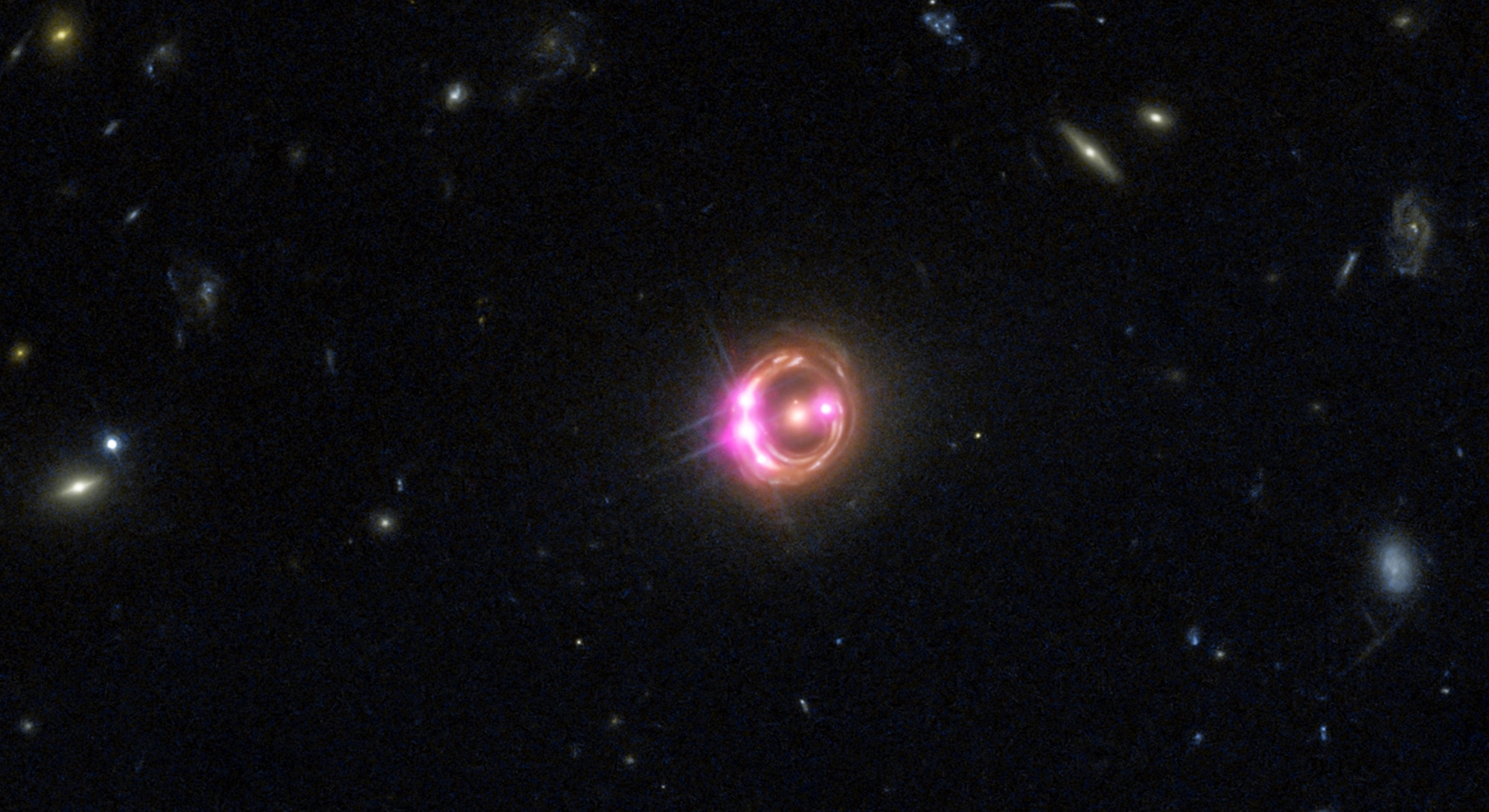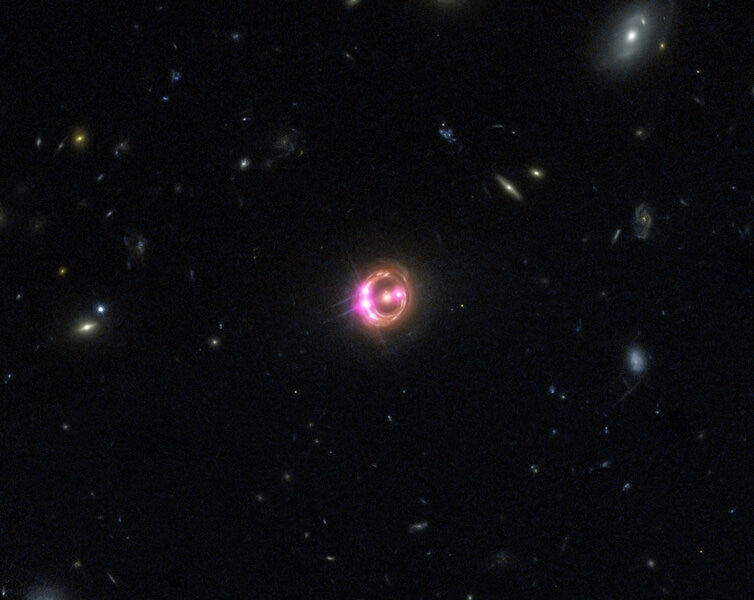Create a free profile to get unlimited access to exclusive videos, sweepstakes, and more!
Astronomers may have found rogue planets… in another galaxy

No, you didn't read the title of this article incorrectly. I can't blame you for thinking you might have: When I first saw the press release for this story I thought it was a typo.
It's not. While it's not 100% confirmed, a pair of astronomers have made a case that they have detected the presence of planets in another galaxy. And not just planets, but rogue planets, ones not orbiting stars. And not just any galaxy, but one about 3.5 billion light years away.
So yeah, this is quite a lot to take in.
I want to be clear that their case is an interesting one, and may in fact be right. It certainly looks good to me, but I'm not an expert in this; I imagine a lot of folks will be looking at this work carefully. The paper has been accepted for publication in The Astrophysical Journal Letters, a premier scientific publication, which means it passes peer review… but I'm sure other experts will be scrutinizing for sure.
Their claim rests on a series of steps, each of which we know works, even though each and in toto they can seem a little bit (or a lot) weird to people not familiar with this science. So let's walk through them.
The most important part of this involves gravitational lensing. I've written about this many times, but here's a succinct description:
Any object with mass — a galaxy, a star, you, me — bends space, literally warps it. We perceive that bending as gravity. If you shoot a rocket past the Moon, the gravity of the Moon bends the path of that rocket.
This happens with light, too. Like a car following a curve in the road, a photon (a particle of light) traveling through the Universe will have its path slightly bent this way and that as it passes by massive objects. The more massive the object (and the closer the photon flies past it) the more the light gets bent. We call objects like these gravitational lenses, because a lens is an object that bends light.
There are a lot of things that can happen because of this. For example, the light from a distant exploding star (called a supernova) goes off in all directions. But if some of that light passes a galaxy, a bit of it that might otherwise miss us gets bent toward us by the gravity of that galaxy. We wind up seeing that light! Sometimes that means we see multiple images of the same object, and sometimes it means the light from a single object gets amplified, making it appear brighter.
Here's a brief video showing the results of this, as light from a distant galaxy is warped by a cluster of galaxies between us and it:
In this new work, the background galaxy (the lens source) is a quasar called RX J1131-1231, a particularly bright galaxy which in this case is about 6 billion light years away (that's a long way, about halfway across the visible Universe!). We think all big galaxies have supermassive black holes in their cores. As matter falls in, it forms a swirling disk called an accretion disk. Matter in this disk gets incredibly hot, and glows fiercely. It's so hot it emits X-rays. This kind of galaxy is a quasar.
The lensing galaxy is part of a cluster of galaxies a little over 3 billion years away. As light from the quasar passes by this galaxy, the gravity of the galaxy warps the quasar's light. The light gets amplified and also split into multiple image; we see four distinct versions of the quasar wrapped around the lensing galaxy (three on the left and one on the right in the image below).
We've known about this lensing of the quasar for a while. But there's another effect, called microlensing. The large-scale lensing we see in the image is due to the entire foreground galaxy, the combined mass of all the stars in it. But an individual star can also act like a lens as well. The geometry is more restrictive, and the star has to be very close to the line-of-sight between us and the quasar, but it so happens that in this case that can happen.
Not only that, but even planets have enough mass to act as microlenses! As small as they are, their gravity is enough to affect the quasar light. Instead of a big arc or multiple images, what we see in a microlens is a small amplification of the quasar's brightness. The planet is assumed to be moving around, and as you observe the quasar, the light from the quasar gets brighter and dimmer over a few days as the planet passes between us and it.
Microlensing is a tried-and-true method, and we've seen it many times. In fact, it's been used to discover planets in our own Milky Way many times. But in this case, we're talking about planets in the lensing galaxy, 3 billion light years away!
The astronomers used data from the Chandra observatory to examine the X-rays coming from the multiple images of the quasar (well, three out of four; the fourth is too faint to get good data from it). They found that the energy of the X-rays (analagous to color in visible light) from the lensed images changes over time. This has been seen before in this quasar. This can happen all by itself, but here's a fun thing: If it were due to something happening in the accretion disk around the quasar's central black hole, it would be seen in all the multiple images of it, usually with some time delay due to the different paths the light takes to reach us. But in this case they're not replicated in the different images! That strongly implies the source of this change in energy is not due to something in the accretion disk itself.
However, this is just what you expect if there is some much less massive lens getting between us and the path of the light taken in one of those individual images of the quasar. Then it would affect one blob, but not the others (the details of this are fiercely complicated, and depend on how the microlens affects the light from different parts of the accretion disk around the quasar's black hole; the journal paper explains all that).
Then, using Einstein's equations for lensing, the astronomers tried to model what sort of objects could be creating these flickers in the energy. In their models they created a field of stars, brown dwarfs (lower mass objects between stars and planets), and a bunch of planets ranging in mass from the Moon to Jupiter. They then took that distribution of objects to see if they could reproduce what they see in the quasar X-ray observations.
Stars, it turns out, can't do it. Brown dwarfs can't either. The only thing they found that replicates the observations were a bunch of planets. And the planets couldn't be bound to stars like the planets in our solar system are bound to the Sun; in that case the host star dominates the lensing effect, and the planets contribute very little. Only rogue planets, planets wandering space by themselves, did the trick.
So there you go: A distant quasar lensed by an intervening galaxy, which itself has planets wandering around inside of it that are acting as microlenses that change the energy of the X-rays coming from the quasar. Simple, right?
But there's more! You can't just have one or two of these planets shuffling around. You need a lot of them to explain all the X-ray energy shifts seen. They ran a bunch of models (using a supercomputer, and even then it took a long time) and found that, for a likely distribution in planet masses, you need roughly 2000 planets ranging from the mass of the Moon to that of Jupiter (or 200 from Mars to Jupiter) per star in the lensing galaxy to explain the number and characteristics of the energy shifts.
That's a lot of planets in total. Like, billions! But that's roughly the number we think there are in the Milky Way; when planetary systems form you make lots of little planets and planetlets (if I may coin a bad term). A lot of them will get ejected from the system as they interact with (move past) bigger ones; the bigger planets' gravity can fling them out and away, into interstellar space. We've detected plenty of these kinds of planets, enough to estimate that they may outnumber planets orbiting stars! Smaller ones with the mass of our Moon would be even more numerous. This means the numbers of rogue planets estimated in this new study are on the high side, but maybe not too silly given what we know.
Mind you, we will never, ever, ever see these planets directly. There may be a planet in our solar system we haven't discovered yet, and these planets are literally about a trillion times farther away!
But this method seems to have unveiled them. I'll be honest, I'm not 100% convinced, but the argument seems to hold water. The methodology looks good. But like I said, I'll be very curious to see what experts in this field have to say about it.
Because if it holds up, this means we can detect planets in other galaxies. That is as startling an assertion as any I have ever heard.
And it may very well be true.















